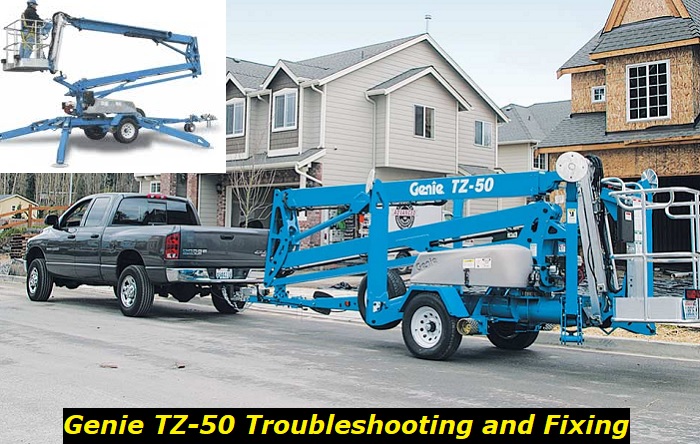Genie TZ50 Troubleshooting - Common Issues and Solutions
The Genie TZ50 is a very reliable piece of equipment for the most part. If it's properly maintained and potential problems are addressed promptly, you could enjoy decades of use of this boom lift.
When operating this boom lift, there are certain problems that you should watch out for, and that includes the most common ones that usually plague its operators. In this article, we will show you the issues that this machine is prone to and the solutions you can apply to mitigate its downtime.

Hydraulic Pump Failure
Hydraulic pump failure in the Genie TZ50 boom lift is a common problem encountered by users. Symptoms of this issue include strange noises, slow performance, and sudden loss of power. To diagnose the cause of this, visual checks should be made to determine if there are any visible signs of leakage or blockage. Tools may also be needed to check internal components such as valves and pumps.
Replacing worn-out parts is usually the best solution for hydraulic pump failure in the Genie TZ50 boom lift. Depending on the severity, some parts may need to be completely replaced while others only require maintenance or adjustments.
The most common components that may need replacing include hoses and seals, hydraulic filters, hydraulic valve blocks, pressure relief valves, and pumps. It is also important to check the pressure of the system and adjust it accordingly.
In addition, proper maintenance can help prevent hydraulic pump issues from occurring in the Genie TZ50 boom lift. Regularly checking and cleaning filters, replacing worn or damaged parts, and lubricating moving components can help keep the system running at optimal levels for longer periods.
Furthermore, be sure to inspect all safety features regularly and always follow the manufacturer's instructions for operation. Keeping up with regular maintenance measures will not only improve performance but also reduce downtime due to unexpected breakdowns.
Riggers Getting Stuck
The Genie TZ50 boom lift's riggers are stuck in a position due to several possible causes. The most common cause is a faulty control switch, which can be identified by checking the manual override switches and running simple tests of the buttons on the platform controls.
Another potential culprit could be a malfunctioning pressure switch, or it might be caused by an obstruction blocking the descent path or preventing the full descent of the riggers.
When assessing the issue, check for mechanical obstructions such as debris on the riggers that may prevent them from lowering. Inspect any visible wires going from the platform control to ensure nothing has become damaged or disconnected.
Check for any loose bolts in suspension mounts that could affect the movement of the lift arm. Lastly, inspect the pressure switch and manually test it to confirm its working condition.
For a successful repair, replacing any malfunctioning or damaged parts is recommended. Components such as the control switch, pressure switch, and wires should all be inspected to determine what needs replacement.
Suspension mounts may need adjustment if they are not properly secured or have become loose over time. Moreover, ensuring all debris has been cleared from the lift arms will prevent future problems with riggers getting stuck in the down position.
Low Battery Power and/or Alternator Failure
The most common cause of a Genie TZ50 boom lift malfunction is an issue with either the battery or alternator. The battery may be dead, have low voltage, or not hold a charge, while the alternator could be faulty due to a bad diode, slipping belt, weak connection, etc.
To properly check-up this issue and determine which one is at fault, it's important to first examine the battery voltage using a multimeter. If the voltage load on the engine is below the required range, then it's likely that the battery needs replacing.
Similarly, if there's no charging of power coming from the alternator, then the diode, belt, or connection to it will also need checking. Any bad connections should be fixed and any worn belts or parts replaced.
If all of these parts are in good condition then further testing may need to be done to ensure that both the battery and alternator are functioning properly. A load test on the battery can determine whether or not it's holding a charge, while an output test can be done on the alternator to see if there is power being generated from it.
If either one of these tests reveals issues then they must be resolved before the Genie TZ50 boom lift will work properly again. This could involve replacing faulty parts such as weak cables, broken diodes, corroded connectors, or a worn belt. Once all of these issues are fixed, the riggers should be able to operate normally again.
If the problem continues, then further investigation may be necessary to determine the cause of the failure and ensure that all components are functioning correctly.
It's important to remember to always consult a professional before attempting any repairs or replacements on Genie TZ50 boom lifts as they are complex machines that require special care when troubleshooting and repairing. Doing so will help avoid potentially damaging the machine and make sure the job is done right.
Overload Indicator Light Falsely Activating
One of the most common causes of the overload indicator in the Genie TZ50 boom lift falsely activating is due to a faulty load sensor. The load sensor measures the weight and detects any changes that might indicate an overload situation. If this sensor malfunctions, it can cause the indicator light to incorrectly activate even when there is no overload condition present.
To evaluate this issue, you need to start by inspecting all components associated with the elevation system. Make sure everything looks normal and that there are no obvious signs of wear and tear. Once that has been done, use a multimeter to check for power coming into each part of the elevation system and make sure they're getting enough voltage. If not, the problem could lie in the power supply.
If you find that all components are receiving power, then it's likely that the load sensor is faulty and needs to be replaced. To do this, you need to first disconnect all of the wires connected to the load sensor before removing it from its mounting bracket.
Then, inspect each wire for signs of wear or damage and replace any if necessary. Finally, install a new load sensor and reconnect the wires in the same order as they were previously removed.
After replacing the faulty load sensor, check for the correct operation of the indicator light on both normal operations and overload conditions. If everything functions correctly, then your Genie TZ50 boom lift should now be back to normal operation. If not, then you may need to look into further potential causes of the problem.
It's important to be aware that this issue can also be caused by other components in the elevation system malfunctioning such as the control board, wiring harnesses, and/or thermal overload relays. If any of these parts are damaged or faulty they could potentially cause the indicator light to incorrectly activate even when there is no overload condition present.
To test if any of these components are causing an issue, use a multimeter for each part and analyze its output to make sure it matches manufacturer specs. If any do not match the spec, replace them with new ones and check for correct operation once more.
Level Sensor Malfunction
The most frequent cause of a level sensor malfunction in the Genie TZ50 boom lift is due to electrical damage caused by corrosion, improper installation, or faulty wiring. Corrosion can occur when moisture has gotten into the level sensor's internal components due to a crack in the housing or sealant failure.
Improper installation may result from incorrect wiring connections that fail to properly secure the wires and ground them correctly. Faulty wiring can be caused by poor maintenance practices such as inadequate protection against environmental conditions like extreme temperatures that degrade insulation layers leading to increased resistance, heat build-up, and eventual wire failure.
To diagnose this issue, you must first inspect all electrical connections for any signs of corrosion, improper installation, or faulty wiring. A multimeter can then be used to test the circuit for resistance, current flow, and voltage levels.
These tests can indicate if there is an issue with the power supply or ground connections that may need to be addressed. Additionally, a close examination of the level sensor's housing should also take place to check for any cracks that could potentially lead to corrosion due to moisture entering the sensor's internal components.
If any of these issues are identified as the cause of the malfunctioning level sensor, they must be corrected to resolve the problem. In most cases, this will involve replacing damaged parts such as wiring and connectors as well as resealing the housing to prevent further corrosion. If corrosion is found to be the issue, any exposed components or wiring must be thoroughly cleaned and treated with a solution to prevent it from occurring again.
After all of these steps are taken, the level sensor should be tested once again using a multimeter to ensure that it is working correctly before it is put back into service.
In some cases, a malfunctioning level sensor may require replacement entirely. Depending on its age and condition, this could include replacing either the entire unit or just certain components such as its electronic boards and sensors. Likewise, the housing may need to be replaced if there is significant corrosion present or if cracks have appeared due to wear and tear over time.
Conclusion
It is important to remember that these issues can be prevented by regularly inspecting and maintaining all electrical components in the Genie TZ50 boom lift.
Taking the time to perform regular maintenance on the machine will help extend its life and reduce the likelihood of it malfunctioning due to electrical damage caused by parts damage, corrosion, improper installation, or faulty wiring.

Add comment